Akinbode O. A.1, Ogunniyan D. J.1, Olasoji J. O.1, Ajijola S.1, Anjorin F. B.1, Olakojo S. A.1, Afolabi C. G.2, Omodele T.1, Kareem K. O.1
1Institute of Agricultural Research and Training, IAR&T, Obafemi Awolowo University, Moor Plantation, Ibadan, Nigeria
2Department of Crop Protection, Federal University of Agriculture, Abeokuta, Nigeria
Correspondence to: Akinbode O. A., Institute of Agricultural Research and Training, IAR&T, Obafemi Awolowo University, Moor Plantation, Ibadan, Nigeria.
| Email: |  |
Copyright © 2014 Scientific & Academic Publishing. All Rights Reserved.
Abstract
It was observed, recently, that some of the controlled diseases are resurging and causing serious yield losses on maize farms. If the diseases outbreak goes beyond economic threshold, food security of the country which maize forms a significant part may be threatened. It is necessary to have information on the type of diseases and the extent of the outbreak in the states. This survey was conducted to confirm the outbreak, evaluate the damage rate in terms of incidence and severity of resurging diseases. Forty maize farms in five states (Oyo, Osun, Ondo, Ekiti and Kwara States) were visited to survey the incidence and severity of diseases on maize. The farms were visited in the second maize planting season October to November, 2013. Farmers were interviewed and other information gathered were on the location (coordinates) of the farms, weather condition, vulnerability of the plants to diseases infection (where farms were isolated), plant growth stage, size of the farms and cultural practices. Data were collected on the incidence and severity of all the diseases found on maize in the various farms. Assessment of these diseases on the farms showed that all the maize farms visited had very high incidence (89.6%) maize streak, (65.0%) rust, (83.30%) leafspot in the season considered. The incidence and severity of maize streak was between 40-100% and 2.0-5.0 respectively across the states surveyed. Maize leaf-spot disease existed on maize in all the farms visited in all the states. The infection recorded was between 0.0 and 100.0% incidence and 0.0 and 4.0 severity. Blight disease was about 20% in the farms visited; probably because of the season. All the farmers sampled (100%) reported that the occurrence of the diseases was prominent on their farms in the second season and that the outbreaks were associated with drought conditions or irregular rains which prevailed at the season in which the survey was carried out. They are aware that improved seed varieties exist, but they do not plant improved seeds because of scarcity (30%), high cost (20%) and ignorance (50%). This survey has shown that maize streak and rust are resurging and rapidly becoming serious problem, so urgent attention is needed to prevent the great yield loss posed to maize by these diseases.
Keywords:
Maize diseases resurgence, Rust, Streak, Leafspot, Blight, Incidence, Severity, Southern western Nigeria
Cite this paper: Akinbode O. A., Ogunniyan D. J., Olasoji J. O., Ajijola S., Anjorin F. B., Olakojo S. A., Afolabi C. G., Omodele T., Kareem K. O., Survey of Resurgence of Maize Diseases in South Western and Kwara States of Nigeria, International Journal of Agriculture and Forestry, Vol. 4 No. 6, 2014, pp. 451-458. doi: 10.5923/j.ijaf.20140406.06.
1. Introduction
Maize (Zea mays L) is the third most important cereal crop in the tropics [3]. It is an economically important grain crop in the world due to its ability to produce economic yields under the marginal production conditions of low soil fertility and management [5]. Total world production of maize in 2007 was estimated at 784,786,580 MT. Nigeria’s share of the production is about 6 million MT [6]. It is a food crop of economic significance and nutritional importance in the human diet; as a major staple food of the people, animal feed, fodder crop and raw materials for industries [13]. But its production is constraint by susceptibility to diseases, insects and vertebrate pests [10]. In the last decade, some of the diseases (mainly blight, rust, streak, Downey mildew and leafspot) that adversely affect production of maize were controlled through the development of resistant varieties and or control measures [1]. Chemical control was not feasible because of its high cost and technicalities involved [4]. It is observed, recently, that some of these diseases are resurging and causing serious yield losses on maize farms. The yields of maize have greatly reduced due to disease infection. The reduction in the crop’s yield in turn affects returns accruable to the maize farmers. The cost of controlling the diseases adds to the cost of production, thus reducing the gross margin.The most prevalent of these recently resurged diseases was the maize streak causing almost total yield loss when infected at the vulnerable stage. The systemic nature of the disease lead to total crop loss, especially if the plants were attacked at the most vulnerable stage. Maize streak virus (MSV; Genus Mastrevirus, Family Geminiviridae) occurs throughout Africa, where it causes what is probably the most serious viral crop disease on the continent. It is obligately transmitted by as many as six leafhopper species in the Genus Cicadulina, but mainly by C. mbila Naudé and C. storeyi. In addition to maize, it can infect over 80 other species in the Family Poaceae [13]. Severe maize streak disease (MSD) manifests as pronounced, continuous parallel chlorotic streaks on leaves, with severe stunting of the affected plant and, usually, a failure to produce complete cobs or seed [10].Maize streak disease is transmitted by Cicadulina leafhoppers. No other method of spread is known. The virus is not transmissible by sap inoculation or by seed. Symptoms of Maize streak virus (MSV) disease consist of broken to almost continuous, narrow chlorotic streaks, which develop along the veins and are distributed uniformly over the leaf surface. The density of streaking depends on varietal susceptibility. The parallel chlorotic streaks may partially or almost completely fuse leaving irregular green lines or islands centered between vein lets. The chlorotic streaks are caused by the failure of the chloroplasts to develop in tissues surrounding the vascular bundles [4]. Since infection of MSV can be initiated only by the Cicadulina leafhopper vector, climatic factors on leafhopper development, survival, fecundity, and migration activity determine, to a great extent, the pattern of streak epidemics.Another major disease that recently resurged is rust. Typical symptoms of rust caused by fungus Puccinia sorghi are chlorotic flecks on leaf surfaces. Flecks developed into oval to elongate reddish brown powdery pustules on upper and lower leaf surfaces. Reddish brown sores break through the leaf epidermis. The pustules become brownish-black in colour as they mature. The mode of spread of these diseases usually include air (rust), vector (insects etc) and man efforts (through the carefree handling of infected plants and inoculum). Reports from some maize farmers’ field and research out-stations of Institute of Agricultural Research and Training (IAR&T), Nigeria in the recent time have shown that there is a new serious outbreak of streak, rust and leaf spot. The fact remains that if the disease outbreak goes beyond economic threshold, food security of the country which maize forms a significant part may be threatened. The Maize Improvement Programme of the IAR&T, Moor Plantation, Ibadan with mandate on southern ecology of Nigeria considered it necessary to have information on the type of diseases and the extent of the outbreak at least in the states covered by the Institute. With this background information, this survey was conducted to confirm the outbreak, evaluate the damage rate of resurging diseases in Oyo, Osun, Ondo, Ekiti states in South Western Nigeria and Kwara State.
2. Main Body
i. MethodologyForty maize farms in five states (Oyo, Osun, Ondo, Ekiti and Kwara States) were visited to survey the incidence and severity of diseases on maize. The farms were visited in the second maize planting season between October to November, 2013. The incidence and severity streak, leafspot, blight and rust on maize were assessed in the farms. Some of the farmers met on the farms or their farmsteads were interviewed during interaction with them so as to obtain information on the diseases infestation. The interview was on following: (i) Their experience in maize cultivation and production.(ii) Awareness of the farmers of streak, blight and rust, through the symptoms or otherwise. (iii) When the disease(s) or their symptom(s) was/were first noticed on their farms.(iv) The degree of diseases infection and severity at the second planting season when the survey was conducted compared to the first planting season.(v) Suspected causes of the diseases.(vi) Number of maize varieties planted; name(s) of the varieties and the varieties most affected (at each planting season). (vii) Sources of their seeds.(viii) Effects of the diseases on their production and yield of their crop.(ix) Their attempt to control the diseases and methods adopted or to adopt to control the diseases.(x) Readiness of the farmers to plant resistance varieties if introduced.(xi) Changes in the market value of their maize produce due to the diseases infection.(xii) Their suggestions on possible remedies to avert the diseases if there are noticed and diagnosed.(xiii) Intervention of government or government agencies (extension agent) on the reduction of diseases in Maize.Other information gathered were on the location (coordinates) of the farms, weather condition, vulnerability of the plants to diseases infection (where farms were isolated), plant growth stage, size of the farms and cultural practices such as weed infestation, plant density and estimated date of planting. Data were collected on the incidence and severity of all the diseases found on maize in the various farms by scoring and counting the number of affected plants per unit area and expressing as percentages. Disease incidence was calculated as percentage infected plants per 30 randomly selected plants per farmer’s field. Severity was determined by screening selected plants and giving an overall note for the symptom severity of each disease. A 1-5 disease severity scale was used to assess the extent of disease in a particular field. Identification of the diseases was based on visual symptoms, and rated as follows: Maize streak: (1) no symptom, (2). Mild chlorotic patterns, (3). Streak pattern on over 70% of the leaves, (4) streak pattern on all leaves, leaf distortion, (5). Stunting of the whole plant.Rust: (1) No visible symptoms on the plant, (2). Visible chlorosis but no uredia are present, (3).50% severity with a moderate number of pustules, (4). < 60% severity with abundant pustules, (5). Abundant pustules; almost all leaves are dried and killed.Blight: (1). Very slight infection; usually on lower leaves, (2). Light infections; moderate number of lesions on low leaves, (3). Moderate infection; abundant lesions on lower and middle leaves, a few on middle leaves, (4). Heavy infection; lesions abundant on lower and middle leaves extending to upper leaves, (5). Very heavy infection; lesions abundant on all leaves, sometimes plant may be prematurely killed (IAR&T, 2001). The data were transformed before subjecting to analysis of variance and mean separation was done using Duncan’s multiple range test or Least significant difference as required.ii. Results and discussionAssessment of these diseases on the farms showed that all the maize farms visited had very high incidence (89.6%) maize streak, (65.0%) rust, (83.30%) leafspot in the season considered. All (100%) of the farmers sampled had planted maize for more than 10 years indicating that the farmers are conversant with maize production and should be able to recognize any disease infection and extend of possible reduction in yield on their crop. The farmers were also expected to know the difficulties which the disease outbreak causes in their production of the crop. These farmers could not recognize the diseases’ symptoms because they mistook the symptoms of the diseases as effects of drought. Other farmers who could recognize the diseases do not know the causes of the diseases. All the farmers sampled (100%) reported that the occurrence of the diseases was prominent on their farms in the second season. Thus it could be concluded that the outbreaks were associated with drought conditions or irregular rains which prevailed at the season in which the survey was carried out. Temperature is undoubtedly one of the most important factors, which influences the occurrence and development of many diseases [9]. The stages of infection are also affected by changes in temperature. Temperature can also affect the rate of penetration of the pathogen into the host. In epidemiology this is often quantified as the incubation period. Both infection and latent periods are influenced by temperature. Latent periods tend decrease with increasing temperature, provided other factors are favourable [9]. Many viral diseases are more virulent when the temperature is high as it is in the states surveyed. The analysis of questionnaires sent to scientists in countries of sub-Saharan Africa revealed virus infection as very important in Nigeria [10] All the farmers sampled planted seeds from their previous harvest. They are aware that improved seed varieties exist, but they do not plant improved seeds because of scarcity (30%), high cost (20%) and ignorance (50%). The farmers rated under reason of ignorance for not planting improved seeds did not have a specific reason for planting improved seeds. They stick to their local landraces because they believe in them. Most of the farmers (85%) do not know the names of the varieties of maize they plant. They planted white and yellow varieties and call the maize by colour. Few of the farmers (10%) planted Quality protein maize (QPM), Suwan 1-SR (15%) This did not allow them know how many varieties they grow.  | Figure 1. Map showing incidence of streak in South Western and Kwara States, Nigeria |
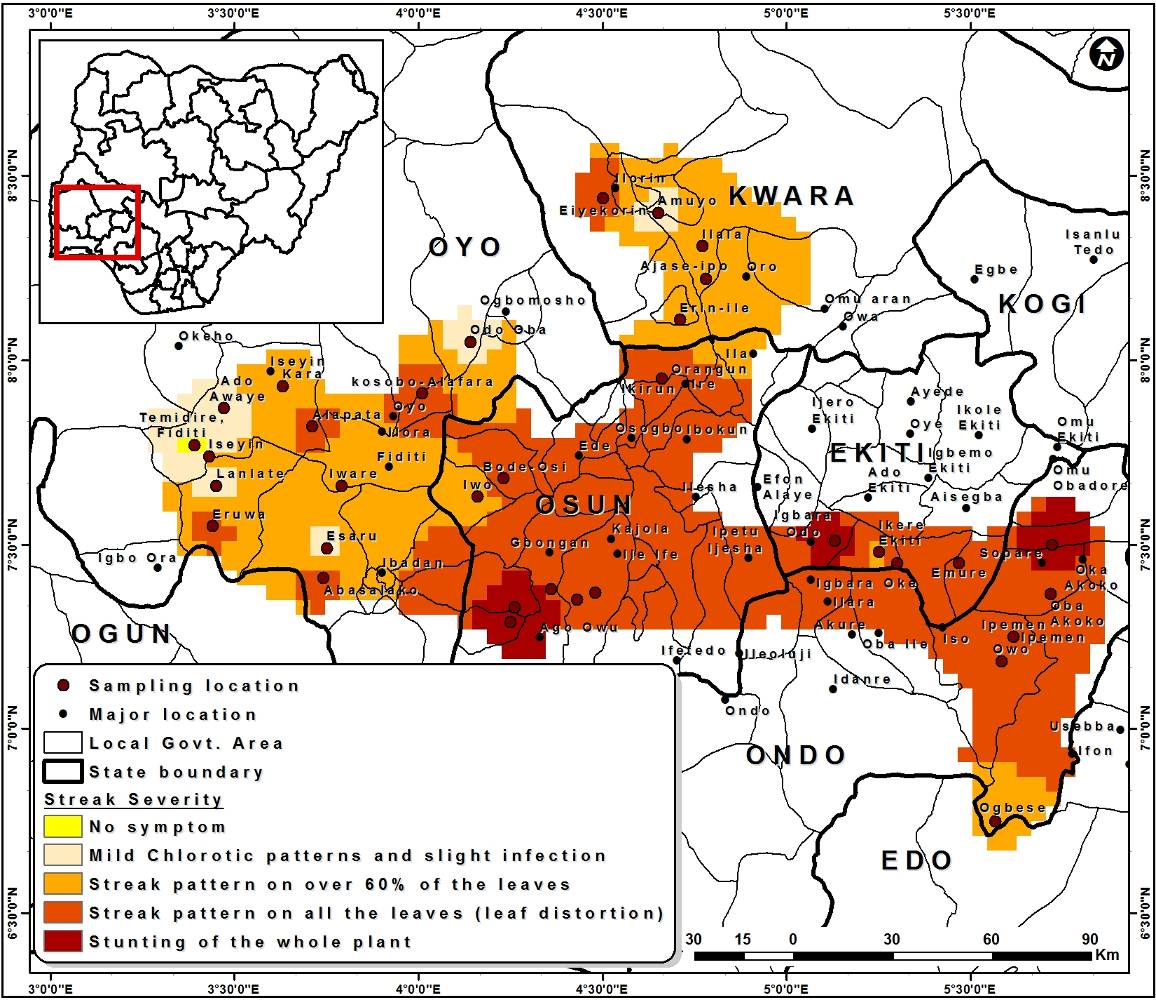 | Figure 2. Map showing severity of streak in South Western and Kwara States, Nigeria |
The incidence and severity of maize streak was ranged between 40 - 100% and 2.0 - 5.0 respectively across the states surveyed (Table 1). Maize streak disease was found to be prevalent in all the states visited, with more than 90% of maize farms having the incidence of 72.0 to 89.6% and severity of between 3.0 to 5.0 (on a scale of 1-5, where 1=no infection and 5 = most severe infection). The diseases appear to infect only maize plants; it does not easily infect other crops such as sorghum, as it was observed during this survey toward Kwara state. The disease development is usually favoured by temperature and humidity.Table 1. Percentage incidence and severity of some resurging maize diseases in Oyo, Ondo, Osun, Ekiti and Kwara states of Nigeria
 |
| |
|
Rust was found in maize farms in Oyo, Kwara and Osun states, whereas a farm at IAR&T in Ibadan (Table 2) had not less than severity of 4.0 score and 80.0% incidence, the whole farm was completely infected by this disease. The farmer was suspected to have abandoned the farm. Maize leaf-spot disease existed on maize in all the farms visited in all the states. The infection recorded was between 0.0 and 100.0% incidence and 0.0 and 4.0 severity. Blight disease was about 20% in the farms visited; probably because of the season. This is because the low humidity in the areas visited; do not favour the proliferation of the causal fungus.Table 2. Maize streak disease and yield loss due to streak with respect to the varieties planted by farmers in Oyo, Ondo, Osun, Ekiti and Kwara states
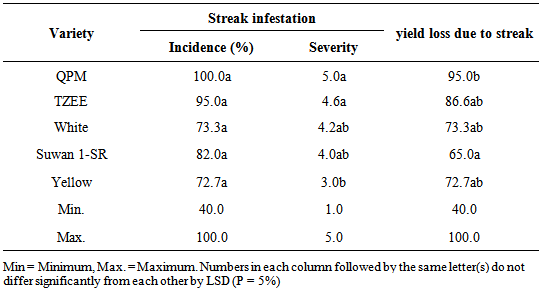 |
| |
|
There were no significant differences in both the incidence and severity of streak, rust and leaf spot on the five genotypes of maize sampled during the survey (Table 1). But yield loss due to streak was highest, was significantly higher and similar in the TZEE, White, and yellow genotypes, but lower in Suwan-1-SR (Table 2). This signifies that Suwan-1-SR is more tolerant to streak infection, hence can be recommended for growth in these areas particularly during the second season. It can also be a source of genes for developing resistant varieties against the current strain of streak disease. There was no significant difference in the outbreak of the diseases due to locations (states). The diseases outbreak was generally high in all the five states (Table 3). The severity of streak was significantly higher not different significantly similar in Ekiti, Osun and Ondo States but lower in Oyo and Kwara State where severity of the disease was also similar. This makes prevention and control measures imperative. The severity of the disease was higher in Ekiti, Osun and Ondo States due to the higher moisture caused by higher amount of rainfall of the states. Oyo and Kwara States are in the savannah with lower annual rainfall thus limited humidity. The outbreaks of maize streak disease are irregular. Since infection can only be initiated by the Cicadulina leafhopper vector, climatic factors on leafhopper development, survival, fecundity, and migration activity determine, to a great extent, the pattern of streak epidemics [4]. Outbreaks of the disease in 1983 and 1984 were associated with drought conditions or irregular early rains, especially in the savanna regions of West Africa [4]. Certainly, the weather conditions prevailing during the cropping season as well as the presence of a diversity of prospective insect vectors in many SSA countries like Nigeria are conducive to successful establishment and perennation of the other maize viruses [4]. A major constraint to the control of this disease. Table 3. Percentage incidence and severity of some resurging diseases in Oyo, Ondo, Osun, Ekiti and Kwara states
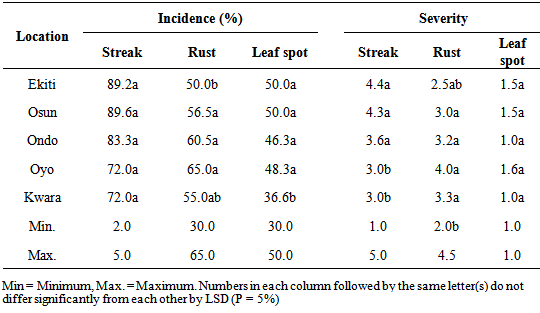 |
| |
|
Curvularia leaf spot disease of maize has been described as one of the major diseases affecting maize plants in the humid tropics [7]. It is now imperative that efforts should be made to continuously evaluate the existing germplasms for resistance to the disease and incorporate resistant genes into the high yielding but susceptible varieties in these states [4].Fig 3 shows the incidence of the diseases on the different maize varieties planted by the farmers. All the varieties were susceptible to the maize streak disease, but it was observed that the QPM (quality protein maize) varieties had the highest incidence of maize streak disease, which was not significantly different from the TZEE variety planted by the farmers but significantly different from the white, yellow varieties and Suwan 1-SR which had lowest incidence of maize streak disease. The incidence of leafspot disease was the least in all the varieties; it was not less than 40% in all the varieties. Though not much, but it is a potential threat to maize production, as the yield will be reduced due to the loss of photosynthetic potentials of the plants as a result of its infection on the leaves. 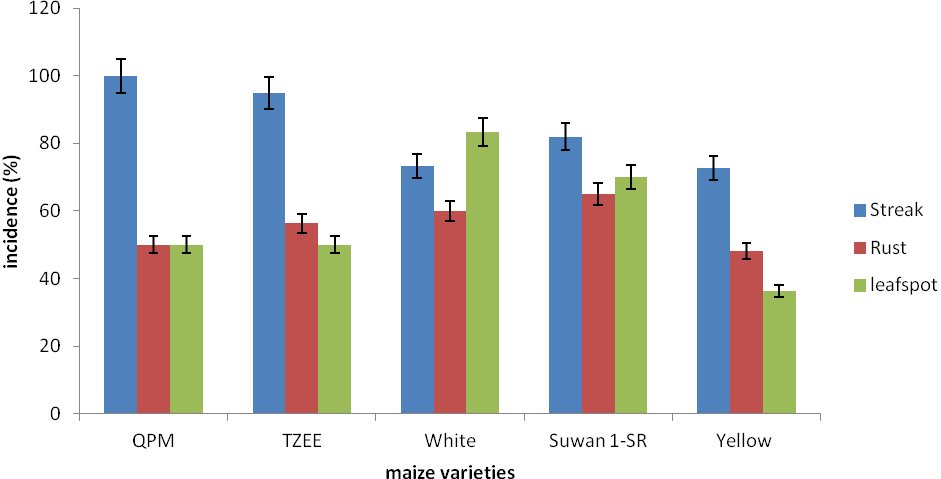 | Figure 3. Incidence of streak, rust and leafspot diseases on the maize varieties grown in the states visited |
The same trend was observed in the severity of these diseases. Maize streak severity of 5.0 observed on QPM varieties which was significantly different from the other varieties which had incidence of between 3.0 to 4.5. Suwan 1-SR is most susceptible maize variety to rust disease in all the varieties considered, it had severity of 4.0, while the other varieties severity had between 2.0 and 3.0. The yellow varieties generally had the least incidence and severity of the diseases surveyed (Fig, 3 & 4), its leafspot, rust and streak incidence were 40%, 50% and 70% respectively with severity of 1.5, 2.0 and 3.0 respectively. This shows that the yellow varieties apart from its appealing colour, are also resistant to diseases that are resurging recently (Fig. 4).  | Figure 4. Severity of streak, rust and leafspot diseases on the maize varieties grown in the states |
The yieldloss due to streak disease of up to 100% was observed in the states and on the varieties (Fig. 5). The yield loss for each variety had a direct relationship with the incidence for all the varieties, except for the Suwan 1-SR which showed a level of resistance as the yield loss was not as much directly related to the incidence of streak. | Figure 5. Incidence and yield loss due to maize streak virus disease on the varieties planted |
 | Figure 6. Incidence of maize streak, rust and leafspot diseases in the five states visited. |
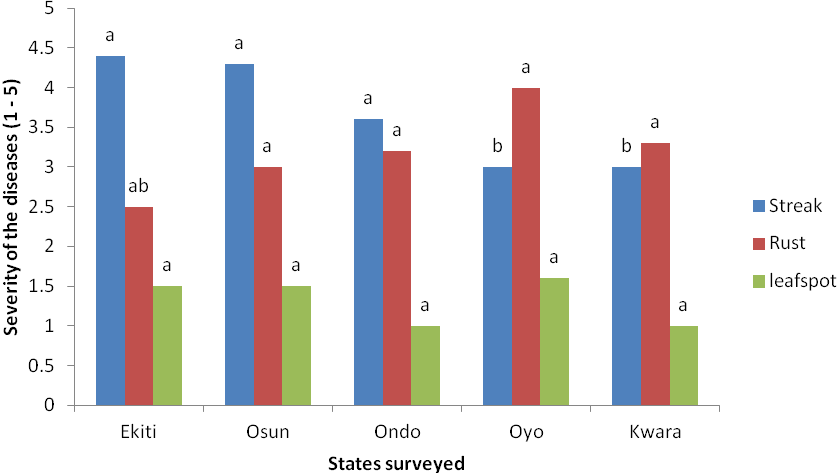 | Figure 7. Severity of maize streak, rust and leafspot diseases in the states surveyed |
3. Conclusions
This survey has shown that maize streak and rust are resurging and rapidly becoming serious problem, so urgent attention is needed to prevent the great yield loss posed to maize by these diseases. Streak, rust and leaf spot are very prevalent in Southwestern Nigeria as well as Kwara State of Nigeria, though more prevalent in Ekiti, Osun and Ondo States. One major reason for this is that farmers still operate traditional seeds supply system. They plant from their own stock and do not plant resistant varieties. Further visits should be made at the two planting seasons to ascertain the time, mode of infection and the strain of pathogen(s) responsible. The synergistic attention of maize breeders, crop protectionists, physiologists, agronomists, extensionists is required to immediately tackle these diseases and recommend short and long term effective control and preventive measures against these epidemics.Meanwhile, these control measures should be considered to prevent further spread and damages due to these diseases;(i) Maize breeders should immediately start breeding programme that will develop varieties that will be resistant to the current strains of the diseases. Pathologists should also identify the strains of the diseases recently observed.(ii) Farmers should be encouraged to plant certified disease resistant varieties. Just as [2] commented about the farmers in Democratic Republic of Congo who were still relying on MSV susceptible varieties are facing high maize yield losses. iii) Scientists should start work on cultural control methods suitable to arrest the current resurgence of these diseases.iv) There should be regular training of agricultural development programme extension/education (ADP) staff by scientists, who will help to disseminate information to farmers.v) Enlightenment programme on radio and television to alert farmers on the presence of these diseases, its symptoms, effects, and precautions to be taken to prevent subsequent reoccurrence.
References
| [1] | Amusa, N. A., Adegbite, A. A. and Oladapo, M. O. 2005. Vascular Wilt of Roselle (Hibiscus sabdariffa L. var. sabdariffa) in the humid forest Region of South-western Nigeria. J. Plant. Path. 4 (2): 122-125. |
| [2] | Asanzi, M.C. 2001. Development and deployment of maize streak resistant varieties: case study of DR Congo. In: proceed. Proceedings of a conference organized by IITA, 4 – 8 June 2001, eds: Jacqueline d’A Hughes and Babajide O. Odu. 284pp. |
| [3] | CIMMYT (International Maize and Wheat Improvement Center) 2004. Maize disease. A guide for identification. 4th edition, Mexico D.F.124pp. |
| [4] | Fajemisin J. M 2001. Overview of maize viruses in sub-Saharan Africa. Plant Virology in Sub-Saharan Africa. Proceedings of a conference organized by International Institute of Tropical Agriculture, 4 – 8 June 2001, eds Jacqueline d’A. Hughes and Babajide O. Odu. 158 – 171pp. |
| [5] | Food and Agriculture Organisation, FAO, 2005. Major food and Agricultural commodities and Producers- Comm. Pg. 1.5 of 1. The Statistics Division, Economic and social Department. Food and Agricultural Organization of the United Nations, Rome, Italy. |
| [6] | Food and Agriculture Organisation, FAO 2007. Green Beans Integrated Pest Management. An Ecological guide. Training resource text on crop development, major agronomic practices, disease and insect ecology, insect pests, natural enemies and diseases of green beans. FAO Inter-Country Program for the Development and Application of Integrated pest Management in Vegetable growing in South and South-East Asia. Section II pp.7 – 8., Rome, Italy. |
| [7] | International Institute of Tropical Agriculture, IITA 1989. Maize production manual, IITA, Ibadan, Nigeria. 45 – 47pp. |
| [8] | International Institute of Tropical Agriculture, IITA 1990. Pages 52 – 53 in Annual Report for 1990. IITA, Ibadan, Nigeria. |
| [9] | Mehrotra, R.S and Aggarwal Ashok, 2006. Effect of environmental factors and nutrition on disease development. In: Plant pathology. Second edition, published by Tata McGraw-Hill Publishing Company Limited, 7 West Patel Nagar, New Delhi 110 008. ISBN 0-07-047399-4. Pp189-198. |
| [10] | Offei, S. K. 2001. Virus and viral diseases of sub-Saharan Africa: analysis of responses to questionnaires by scientists in sub-Saharan Africa. In: Plant virology in sub-Saharan Africa. Proceedings of a conference organized by IITA, 4 – 8 June 2001, eds: Jacqueline d’A Hughes and Babajide O. Odu. 128- 136pp. |
| [11] | Olakojo, S.A and Iken, J.E. 2001. Yield performance and stability of some improved maize (Zea mays L) varieties. Moor Journal Agricultural Research. 2:21-24. |
| [12] | Omueti J. A., Amusan, T. F., Ashaye, K. 1993. Evaluation of the garri from market and processing centres for cyanide and moisture content in some States of Nigeria. Nig. Food J., 11: 135-144. |
| [13] | Shepherd, D. N., Martin, D.P., Van Der Walt, E., Dent, K., Varsani, A., Rybicki, E. P., 2010. Maize streak virus: an old and complex 'emerging' pathogen. Mol Plant Pathol. 2010 Jan.11 (1):1-12. |








 Abstract
Abstract Reference
Reference Full-Text PDF
Full-Text PDF Full-text HTML
Full-text HTML

